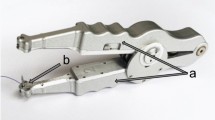Abstract
We present a simple new suture technique for an arthroscopic portal that enables a secured subcutaneous suture without thread exposure. A curved suture needle is inserted through the skin at approximately 1 cm from the wound edge. The needle penetrates the subcutaneous tissue and exits through the skin on the opposite side of the wound edge. The needle and suture are pulled from just underneath the skin layer. The thread is collected within the wound, and the other end of the thread is pulled from the wound. The needle is inserted at just beneath the skin layer, penetrates the subcutaneous tissue, and pierces the opposite side of the skin. The needle is retrieved along with the thread at approximately 1 cm from the other side of the wound edge. After removing the needle from the thread, the thread passing in the wound is located and the needle side of the thread is retrieved from the wound. The ends of the thread are tied under the appropriate tension. From our findings, we recommend this method for suturing of all arthroscopic portals, as well as other small incisions that need water-tight suture.

Similar content being viewed by others
References
Acar N, Er A, Erduran M (2017) The assessment of portal-tract healing after knee arthroscopy. Acta Orthop Traumatol Turc 51:372–376
As-Sultany M, Porter P (2012) A simple suturing technique to close arthroscopy portal wounds. Ann R Coll Surg Engl 94:441
Nacius LA, Pascual-Garrido C, Sagiv P, Mei-Dan O (2012) Skin closure after arthroscopy utilizing a pull-out bow-tie subcuticular suture. Muscles Ligaments Tendons J 4:404–406
Gristina AG, Price JL, Hobgood CD et al (1985) Bacterial colonization of percutaneous sutures. Surgery 98:12–19
Frcs JAF, Moran CG, Surgey O (1987) The use of sterile adhesive tape in the closure of arthroscopic puncture wounds: a comparison with a single layer Nylon closure. Sr Lect Orthop Surg 69:140–141
Small NC (1986) Complications in arthroscopy: the knee and other joints. Arthroscopy 2:253–258
Sikand M, Murtaza A, Desai VV (2006) Healing of arthroscopic portals: a randomised trial comparing three methods of portal closure. Acta Orthop Belg 72:583–586
Hussein R, Southgate GW (2001) Management of knee arthroscopy portals. Knee 8:329–331
Acknowledgements
Acknowledgments of people, grants, funds, etc., should be placed in a separate section on the title page. The names of funding organizations should be written in full.
Author information
Authors and Affiliations
Corresponding author
Ethics declarations
Conflict of interest
The authors declare no conflicts of interest associated with this manuscript.
Additional information
Publisher's Note
Springer Nature remains neutral with regard to jurisdictional claims in published maps and institutional affiliations.
Rights and permissions
About this article
Cite this article
Hiranaka, T., Tanaka, T., Fujishiro, T. et al. A subcutaneous arthroscopic portal closure technique without thread exposure. Eur J Orthop Surg Traumatol 30, 383–385 (2020). https://doi.org/10.1007/s00590-019-02573-6
Received:
Accepted:
Published:
Issue Date:
DOI: https://doi.org/10.1007/s00590-019-02573-6




